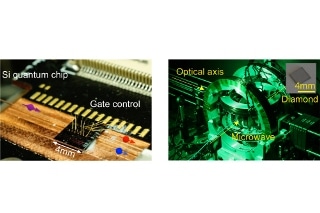Mar 17 2017
 Integrated silicon-photonic quantum processor (left); Set-up for nitrogen-vacancy centre's spin manipulation in diamond (right) (Credit: University of Bristol)
Integrated silicon-photonic quantum processor (left); Set-up for nitrogen-vacancy centre's spin manipulation in diamond (right) (Credit: University of Bristol)
Quantum computing will soon enter a new era of quantum supremacy, where quantum computers are expected to provide a better computational performance than classical computers, paving the way for new technologies and applications such as processing big data and designing new drugs.
However, before such a great goal is realized, a question still remains as to how to calibrate current quantum computers and how to verify computing outcomes of these systems?
Now, a quantum-enhanced machine-learning technology has been demonstrated by an international team of scientists headed by researchers from the University of Bristol’s Quantum Engineering Technology Labs (QETLabs), enabling a quantum computer to be used to efficiently learn the development of other quantum devices and systems.
Researchers from the Eindhoven University of Technology in the Netherlands and Microsoft’s Quantum Architectures and Computation Group (QuArC) in the USA were also part of the international team.
The study results have been reported in the Nature Physics journal.
Predicting the behavior of complicated quantum systems and characterizing large quantum devices are issues considered to be intractable by classical computers, due to the nature of large space of quantum systems. Exploiting classical machine learning along with quantum computing to gain knowledge of another uncontrolled or unknown quantum system is the major motivation behind this work.
In this study, the researchers characterized and certified a reprogrammable two-qubit silicon quantum photonic processor using a kind of machine learning method known as Bayesian inference.
Using the silicon photonic processor as a quantum simulator, the researchers showed the efficient learning of an electron spin in a diamond nitrogen-vacancy color center.
As an elegant example, in our work, we show the learning of an electron spin on a photonic chip by using a machine-learning tool. This technology, called quantum Hamiltonian learning, is extremely useful to study the underpinning models of physical systems, with potential applications to different science and engineering areas.
Dr Jianwei Wang, Lead Author
Dr Nathan Wiebe from Microsoft Research explained: "Machine learning will play a key role in the efficient characterization, verification and validation of future quantum devices such as quantum computers, and also in the understanding and controlling of complex quantum system, e.g. chemical molecules."
The optical circuits on silicon, the same material as used in our microelectronic circuits, allow the processing of information carried by a single particle of light. Silicon based quantum photonics technologies allow the potential integration of tens of thousands of components on a single, tiny chip, promising numerous applications in the fields of communication, simulation and computing.
Professor Mark Thompson, Bristol Research Team Leader